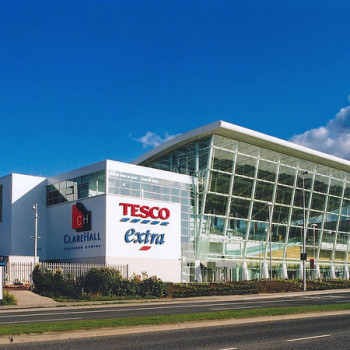Tesco problems point the way to retail’s no-frills future

It’s been a bad month for Tesco but it seems like the retail giant is not the only one to be facing problems caused by the rise of the discounters. Dan White reports
15 October 2014
The fallout from the rapidly worsening crisis at Tesco will spread far beyond Britain and Ireland’s largest retailer. By the time the dust has settled on the Tesco affair, we will be looking at a very different retailing landscape.
On 22 September Tesco revealed that it had over-estimated its first-half profits by as much as £250m. This means that Tesco’s trading profits for the six months to 23 August are likely to be about £850m rather than the £1.1bn guided to analysts at the time the company published its first-half trading update at the end of August.
The sensational news from Tesco would have been a shocker even at the best of times. But these aren’t the best of times for Tesco, far from it. Even before the 22 September announcement Tesco had in short order issued two profits warnings, slashed its interim dividend by 75% and fired its previous chief executive.
Fall in share price
Coming on top of this tale of woe the news of the profit understatement, which seemed to indicate that Tesco had lost control of its finances, had a seismic impact. The share price, which had already fallen by over 40% since the departure of former chief executive Sir Terry Leahy in February 2011, fell even further and now stands at less than half of its February 2011 level. The whole of Tesco is now worth just £14.5bn, down almost £18bn over the past three-and-a-half years.
Then, as if to add insult to injury, the UK financial watchdog, the Financial Conduct Authority (FCA), announced on 1 October that it was investigating the profits overstatement. Tesco’s fall from grace was now complete.
Are other retailers in the same boat?
When looking at Tesco’s plight the key question that needs to be answered is how much of its problems are specific to the company and how much reflect wider difficulties being experienced by the entire retail sector? Was the profits over-statement, which was apparently caused by the company booking supplier payments upfront while delaying recognition of the associated costs, unique to Tesco or are other retailers indulging in similar practices?
No doubt the FCA investigation will shed greater light on the details of what actually went wrong at Tesco but, even at this early stage, it is clear that at least some of the lessons to be learnt from the affair will apply to all retailers.
On both sides of the Irish Sea the traditional grocery retailers have been hit hard by the rise of the German hard discounters, Aldi and Lidl. Between them the discounters are up to 8% of the UK market and a massive 17% of the Irish market.
In both markets it has been Tesco which has been hit hardest by the rise and rise of the discounters with its UK market share falling from a peak of over 31% to its current level of less than 29% and from over 28% to 25.2% in Ireland. Quite clearly Tesco has been unable to devise an effective response to the threat posed by the discounters.
Discounters affecting whole sector
However, while Tesco has undoubtedly suffered most at the hands of the discounters, the other traditional grocery retailers have not emerged unscathed either. In recent decades the traditional grocery retailers have developed ever more sophisticated distribution networks, stock control systems and customer loyalty programmes. This has been underpinned by a huge investment in IT and enormous out-of-town stores, often of 100,000 square feet or even more.
The rise of the discounters threatens to render this retailing model obsolete. Whereas the large supermarket carries over 50,000 lines, the average 15,000 square feet Aldi or Lidl store carries less than 2,000. Customers, if the rising market share of the discounters is any guide, don’t seem to miss the huge range of items stocked by the traditional supermarkets all that much.
While no-one is suggesting that Tesco totally imitates the discounters and prunes its range to just a couple of thousand items, does it really need to stock quite so many lines? UK rival Morrisons, which has had its own well-publicised problems with its former treasurer Paul Coyle having been charged with insider trading last month, is trialling a new store at Preston that stocks 20% fewer lines.
Will Tesco be tempted to follow suit?
What Tesco has already done under newly-installed chief executive Dave Lewis is to signal its intention to drastically cut back on the number of large supermarkets. He was barely a wet day in the job when Tesco announced that it was mothballing two new large stores that were due to open later this year.
Most analysts are convinced that this will be only the start of a process that sees Tesco close or reduce the size of many of its larger stores as it attempts to adapt to the change in consumer habits which has seen the old weekly or fortnightly “big shop” give way to “little and often”. Shoppers are now spreading their custom about, making more frequent trips to the supermarket or discount outlet but spending less on each trip.
Big no longer beautiful
In this changed retail environment big is no longer beautiful. Tesco’s estate of large stores, once seen as perhaps its greatest asset, is increasingly looking like a liability. Ironically the success of RGDATA in persuading the Irish government to cap the size of supermarkets in this country may ultimately have worked to Tesco’s benefit. Maybe Tesco should send former RGDATA director general Michael Campbell a very large hamper this Christmas!
Question marks are also being raised about the future of Tesco’s Clubcard loyalty programme. It was introduced by former Tesco chief executive Sir Terry Leahy in 1995 and quickly copied by all of its major competitors on both sides of the Irish Sea.
Do loyalty cards really create loyalty?
While Clubcard gave Tesco an unprecedented insight into the shopping habits of its customers it comes at a very heavy price with analysts estimating that it costs up to £500m a year, more than 1% of Tesco’s UK turnover. The lack of a loyalty card doesn’t seem to have hindered the progress of either Aldi or Lidl.
Quite clearly the Tesco implosion does have implications for other retailers also. If the company’s recent misfortunes are any guide then the future of the grocery market is likely to be one of less lines, smaller stores and fewer frills such as loyalty cards.



 Print
Print




Fans 0
Followers